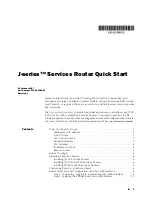
What You Need To Know
Management IP Address
When you first connect a management PC or laptop to a built-in Ethernet port on a
Services Router, the router acts as a DHCP client and attempts to perform an
autoinstallation. If it does not find a DHCP server, the router assigns
192.168.1.1/24
as the IP address for port 0. (If you are connected to port 1,
192.168.2.1/24
is
assigned as the IP address. On the J2320, J2350, J4350 and J6350 routers, port 2
and port 3 are assigned
192.168.3.1/24
and
192.168.4.1/24
, respectively.)
Because this address is not part of any explicit configuration, it is removed when
you change the configuration
in any way
. You must configure an IP address for this
LAN port when you commit your initial configuration. (See “Step 4. Configuring Basic
Settings with J-Web Quick Configuration” on page 11 or “Step 4. Configuring Basic
Settings with the CLI” on page 14.)
J-Web Access
The Web interface to the router—called the J-Web interface—is enabled by default.
To configure the router with the Web interface, you attach a PC or laptop to a built-in
Ethernet port. The examples in this document use the first built-in Ethernet port:
■
On J2300 routers, the first built-in Ethernet port is Fast Ethernet
PORT 0
(internally
named
fe-0/0/0
).
■
On J2320, J2350, J4350 and J6350 routers, the first built-in Ethernet port is
Gigabit Ethernet port
0/0
(internally named
ge-0/0/0
).
See “Step 1. Connecting, Logging In, and Starting the J-Web Interface” on page 9.
CLI Console Access
Services Routers are shipped with a console cable and adapter. To configure a Services
Router through the console port with the JUNOS command-line interface (CLI), you
use a terminal emulation program such as Microsoft Windows HyperTermimal. (See
“Step 1. Connecting, Logging In, and Starting the CLI” on page 13.)
Required Licenses
To use the following features on a Services Router, you must purchase a license. (See
“Step 3. Adding Licenses with the CLI” on page 14 or “Step 4. Configuring Basic
Settings with J-Web Quick Configuration” on page 11.)
■
Advanced Border Gateway Protocol (BGP) support for route reflectors
■
Data link switching (DLSw)
■
J-Flow traffic analysis
What You Need To Know
■
3
What You Need To Know




































